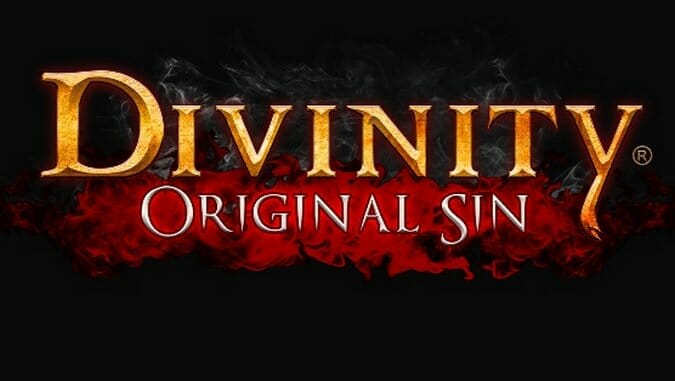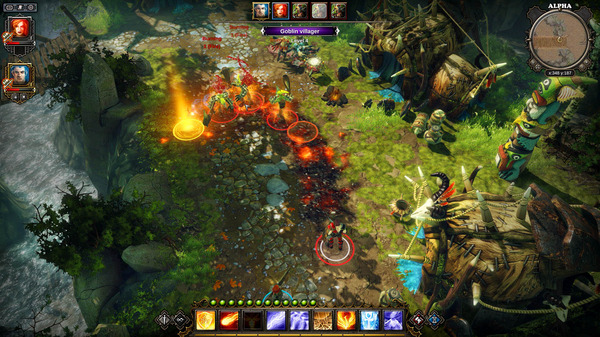Divinity: Original Sin (PC/Mac)

It took nineteen hours for me to understand what I was doing in Divinity: Original Sin.
One of the rare Kickstarted games that has managed to be released without running dry of funds or going down in a flaming wreck, Original Sin is clearly tapping into the same gameplay nostalgia circuits that Wasteland 2, Shadowrun Returns and Torment: Tides of Numenera are all hooking into. Hearkening back to titles like Baldur’s Gate II, these games want to give you two things: massive, immersive stories and fine-grained combat.
The reason for this is that the genealogy of these games directly links up with the tabletop standard Dungeons and Dragons. Take it back one step and you’ll find war games. One more and you’ve got historical battle simulations. Those games were, and are, based in attempting to explain why a battle happened by showing the mechanisms that were involved: terrain, troop position, commander knowledge, and a host of other things. Put another way, battle simulations want to tell an explicit historical story by providing you with a fine-grained understanding of the way that battles happened. In passing down hereditary traits, things haven’t changed that much.
While I took the long way around, that historical knowledge gives particular insight into the first nineteen hours in Original Sin. The game itself begins with character creation, and that character creation is 90% about picking your class. In the Baldur’s Gate games, this process was about choosing classes, assigning stat points and determining what spells or weapons you can use. In Original Sin it involves clicking through the list of classes and selecting one. Moments later I’m a pair of Source Hunters trying to solve some problems in an isometric world full of wonderment and numbers. Lots of numbers.
These numbers are the reason that I’m stressing the species relationship between battle simulations and Original Sin. At various times I found them impenetrable, in the case of the skill system, or incredibly clear, in the case of the battle log that presents you with all of the numeric checks made in combat. There is no effort made on the part of the game to educate the player on the various numbers that control her gameplay experience; instead, it is up to her to intuit or figure out the relationships between those numbers and various outcomes in the game.
Most of those outcomes involve hitting someone or something with a sword, axe, club, lightning bolt, fireball or other fantasy staple. The reason that you have to pay such close attention to the numbers is that the battles in Original Sin are incredibly difficult. I say that as someone who has played through the classics of this genre on normal difficulty within the past few years. I breezed through Planescape: Torment, hopped through Baldur’s Gate, and almost freeform expressive danced my way through its sequel. However, there has always been a contingent of players of those games who found normal difficulty to be insulting while feeling that hard was merely child’s play. The developers of Throne of Bhaal added in Watcher’s Keep, a notoriously complex and difficult dungeon, to placate fans of difficult strategy in these games, but it wasn’t really sufficient. To get the true challenge they sought, players created mods of current content and added in additional content of their own to scratch their itch (if the scratching agent was a forty five minute battle with fifteen demons, vampires and assorted enemy mobs.)
This group is who Divinity: Original Sin is implicitly targeted at—the hardcore fan. By virtue of not being in this challenge-seeking cohort, I spent my first fifteen hours in the game hating it. There were some fights that I was starting over ten or fifteen times. The difference in a single hit five or six turns into a battle would signal a loss later; I reloaded often. My fighters had a hard time hitting things with their weapons, and my casters never seemed to be in the right place at the right time. Original Sin’s unique mechanic of floor effects (where things like water, ice and fire stay on the battlefield to get things wet, cold or burn-y) always seemed to hinder me more than help me. I was on fire a lot, and not in a good way. Many party members had to be saved from death’s embrace via quickload.
Then things clicked. I hit a certain level in the game and a certain level of familiarity with the game’s tactical system and things began to come more easily. Only through an intense immersion within those systems could I begin to understand them well enough to excel and thrive. There was no tutorial or manual that I could see to get me familiar with these systems. This is maybe a strange place to bring this up, but I believe that my encounter with Original Sin says something about our current culture of previews and video content. I have done a lot of work over that past couple of years to avoid as many trailers, sneak previews and hands-on articles about games as possible. I actively make an attempt to know nothing about a game before I begin playing it. Generally, that has increased my enjoyment of games across the board. With no expectations, I can really only be impressed.
On the other end, I have noticed that developers have begun leaning on these previews in order to educate consumers about their games before release. I don’t mean that they’re using them for advertising. I mean that there were entire sets of mechanics in Watch Dogs that have no instructions in-game, but were featured so heavily in preview material that players were already familiar with them and how they worked. I wasn’t, and therefore I was confused.
While Original Sin isn’t as egregious as that, I definitely had the feeling that I was supposed to be “in the know” about how the game worked before I actually began the game. While I lay this at the feet of preview culture, it could also be a symptom of being a role playing game that is attempting to tap into the feeling that Ultima, Might and Magic or Exile gives the player. This is a world full of possibility and you’ve stumbled into it; learn to deal. I highly suggest watching some YouTube videos about this game before you jump in. Learning to deal is a tough time.
